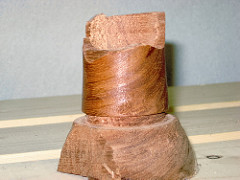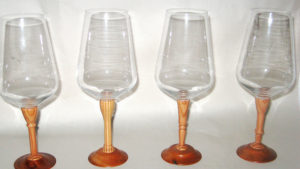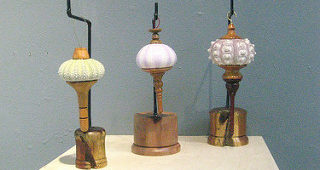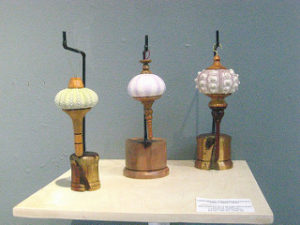Craftsmanship – The quality of design and work shown in something; artistry. Oxford Dictionary
What is the effect of long-term dedication to a craft? I know from the calluses in my palms that woodturning is having an effect on my body but is it doing something to me at a deeper level? I’d say yes.
Since I’ve started, there have been multiple phases of development and I believe (hope) that there will be more. Let me explain the three stages that I’ve gone through so far.
Stage 1. Overly Ambitious Amateur
When I first started out as a woodturner, I fought with the tools, I fought with myself and I tried to use brute force to make the wood into the shapes that I wanted. Frequently the result of this approach would be broken or damaged wood, and frustration. One night in a fit of rage I threw the gouge down with so much force that it bounced up and cut my calf. Paradoxically, these early attempts were attended by fantasies of me as a famous artist, surrounded by groupies and commanding Rothko-like prices. Treating your own art as your worst enemy is not uncommon. In fact, it plays a big role in the ‘tortured artist’ stereotype but it is possible to move on from this stage where all of the focus is on the external.

broken woodturning
Stage 2. Analyzing Apprentice
My second stage of development was on improving technical competence. I knew it was impossible to do all things well so I would specialize in just one thing, making drinking glasses. Drinking glasses were not the only thing I made but I spent the bulk of my time doing them. Years, went by in which I experimented with martini glasses, white and red wine glasses and my best seller, champagne glasses. The gluing process required trial and error for the better part of five years. Some glues would not stick to glass, some dried too brittle others were too fluid. During this time I spent hours lurking in chat groups and less time in the workshop. My search for knowledge on how to make specific cuts, best tools to use for the things I wanted to make, and finishes was endless. Any new knowledge was squirreled away in Google docs (that I can no longer find) or printed and put in a binder (that I now hardly open). I archived bits of information that seemed deadly important at the time but have since ignored because I moved on and formed my own opinions based on experience. This period would best be described in one word, OVERANALYZING. Yet, it was through this process that I stumbled onto the path.

Wooden stemmed wine glasses
Stage 3. The Outward Touches the Innermost
English is a wonderful language, but it has its limitations. For instance, the word craftsmanship does adequately define the outward expression of serious artistic endeavour. Its limitation is that the English language lacks words that explain personal development through artistic struggles. Of course, other languages are not so limited. The Japanese, it would appear, have a word for everything, particularly for the more nuanced aspects of human life.
Geijutsu- Creating art that is useful. Beauty that is to be used in life but still embraces the pursuit of perfection.
Duende (Spanish) – To be deeply moved, have a physical/emotional response to a work of art.
What is perfection? Do we know it when we see it? Can duende be deliberately created or is it hit or miss? Would it be possible to create truly awe-inspiring works of art without contributing a part of your soul?
I cannot answer these questions at this time, but, I am grateful to know that they exist within me and that others have experienced similar feelings.
Now, I no longer dream of groupies and fame, (not true, I still do but only a little) instead I am thankful for the personal growth that has taken place. I have organized and participated in art shows. There is no longer any reason to fight with the tools, or myself. I understand that different types of wood have different ‘personalities’ and therefore cannot be forced into shapes. There is now calm intention, acceptance, and adjustment in the place of anger and frustration when things go wrong. But, most importantly, I sometimes glimpse what perfection of my craft would be like, and it is this touch of the sublime that keeps me enthusiastic and motivated in my work.
What more could any craftsman want?
Resources:
For more on the deeper implications of Craftsmanship read these:
Measure Twice, Cut Once: Applying the Ethos of the Craftsman to Our Everyday Lives
Art and Nature in Japan. Reflections on Bonsai


Speak Your Mind